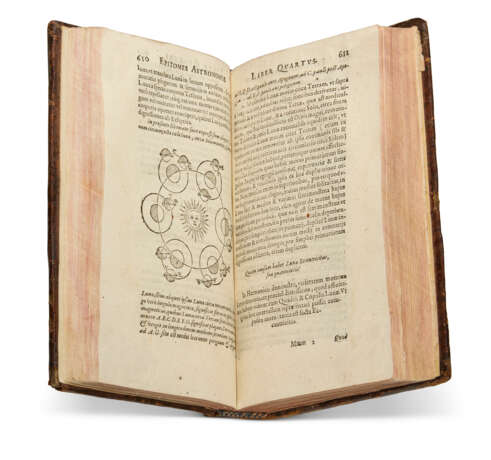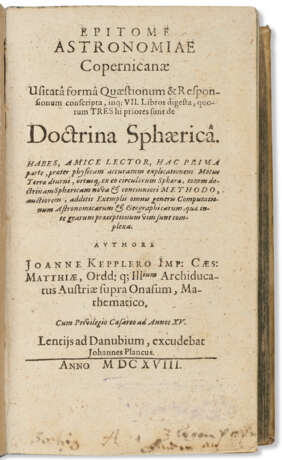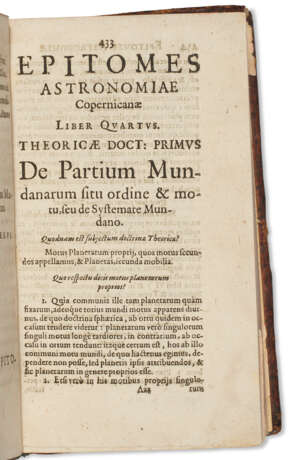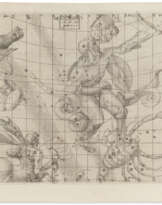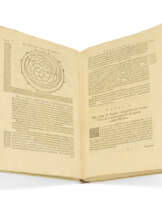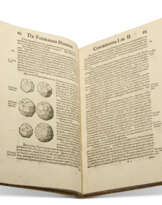ID 1360821
Los 105 | Epitomes astronomiae Copernicanae
Schätzwert
$ 10 000 – 20 000
First edition of “Kepler’s longest and most influential work” (DSB) including the first full exposition of Kepler's third law of planetary motion. Following the publication of his Astronomia nova in 1609, Kepler was asked to write a more popular exposition of Copernican astronomy; however, "despite its title, Kepler's Epitome was more an introduction to Keplerian than to Copernican astronomy" (ibid.). The work was written during a period of upheaval—Kepler’s mother had been charged with witchcraft and threatened with torture—and the first volume's advocacy of the Copernican system soon earned it a place on the Index librorum prohibitorum. The seven books were issued in three inexpensive octavo volumes, titled "Doctrina spherica," "Physica coelestis," and "Doctrina theorica," over a period of some three years in two cities, due to the financial strains under which both Kepler and his publishers suffered.
With regard to the motions of the Earth, Kepler extended Copernicus' work and correctly formulated the principles which Galileo would in turn discuss in more detail in his Dialogo of 1632. Book 4, on theoretical astronomy, contained the most original expositions of Kepler’s own work: “subtitled, 'Celestial Physics' ... to a great extent [book 4] epitomized both the Harmonice mundi and the new lunar theory that Kepler completed in April 1620 ... The harmonic law, which Kepler had discovered in 1619 and announced virtually without comment in the Harmonice mundi, received an extensive theoretical justification in the Epitome” (ibid. p. 303). The harmonic law was Kepler’s third law of planetary motion: that the square of a planet's orbital period is directly proportional to the cube of the semi-major axis of its orbit.
It is Book 4 that is most bibliographically fascinating in the present set. After completing the first three books, Kepler took a break to write the Harmonice mundi, which was published in 1619. He finished writing the second part of the Epitome in the late spring or summer of 1620 and sent it to press, barely overcoming the failure of his first sponsor, the Augsburg publisher, Crüger. However, in August of 1620 when only the text of Book 4 had been printed, Kepler was called home to Swabia at a crisis in his mother’s witchcraft trial. Kepler tells us that he took 17 copies of Book 4—without the title-page or reader’s address—with him from Linz to Swabia (see letter to Bernegger, 15 February 1621). The title-page and address to the reader for Book 4 were not printed until winter of 1620/1621 in Linz and then it was also reprinted in Frankfurt and dated 1622. It used to be thought that Book 4 had not been published at all until 1622. In the present set, like the ones taken by Kepler from Linz to Swabia in August 1620, there is no title-page or reader’s address for Book 4, indicated it may be an early issue. In this set, the text for Book 4 is bound after the title and dedication for Books 5-7. Caspar 55, 63, 69; Houzeau & Lancaster 11831.
Two volumes, octavo (161 x 92mm and 158 x 89mm). The first volume is a sammelband with the first part of Kepler’s Epitome (Books 1-3) plus two other works—by Gigas and La Rocheposay. The second volume contains the second and final two parts of the Epitome (Book 4 and Books 5-7). Woodcut illustrations, head- and tail-pieces and initials. Folding letterpress table at p.112 of Systema cosmographicum (This copy without the folding letterpress table at p. 821—never present, the leaves are not fully opened at this page, and without the first gathering of part 2 with title and address to the reader, see note above; erasures to title page of part 1, some very mild wear/spots to prelims of both vols., both vols. partially unopened). First volume in old vellum over boards, spine faintly lettered in manuscript (stained, upper hinge weak). Second volume in blind-ruled calf (rubbed, spine started, endpapers renewed). Provenance: “IL” (blindstamped to upper cover of vol. 2) – erased inscription and erased stamp to vol. 1 title – Owen Gingerich (bookplates).
| Künstler: | Johannes Kepler (1571 - 1630) |
|---|---|
| Herkunftsort: | Osteuropa |
| Künstler: | Johannes Kepler (1571 - 1630) |
|---|---|
| Herkunftsort: | Osteuropa |
| Adresse der Versteigerung |
CHRISTIE'S 20 Rockefeller Plaza 10020 New York Vereinigten Staaten | ||||||||||||||
|---|---|---|---|---|---|---|---|---|---|---|---|---|---|---|---|
| Vorschau |
| ||||||||||||||
| Telefon | +1 212 636 2000 | ||||||||||||||
| Fax | +1 212 636 4930 | ||||||||||||||
| Nutzungsbedingungen | Nutzungsbedingungen | ||||||||||||||
| Versand |
Postdienst Kurierdienst Selbstabholung | ||||||||||||||
| Zahlungsarten |
Banküberweisung | ||||||||||||||
| Geschäftszeiten | Geschäftszeiten
|
